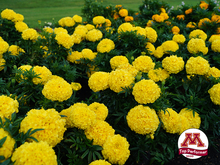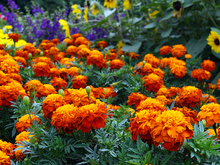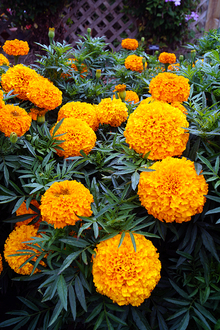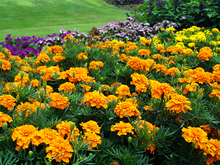Quick facts
- Marigolds are very easy to grow and grow fast, which makes them great for children or gardening newbies.
- Marigolds need full sun all day to provide blooms all season long.
- Three common types are French, African, and Signet.
- Marigolds naturally repel pests such as deer or rabbits since they find their odor offensive.
Several species of marigolds are used as ornamental annuals and are very popular all around the world due to their ease of growing. Native to Central America and Mexico, these low-maintenance plants thrive in full sun locations and will provide abundant blooms up until frost.
Blossoms can be orange, yellow, red, gold, copper, brass, white, or any combination of those colors. Foliage has a distinct odor that deer and rabbits tend to avoid, making marigolds great companion plants to other plants in order to deter pests.
There are three main types of marigolds: French, African, and Signet. Despite the names, African marigolds did not originate in Africa and instead are called that because they were first imported to Europe via a trade route that passed through northwest Africa. French marigolds derived their name from their popularity in French gardens.
- French marigolds (Tagetes patula) have a busy and compact growing habit and are usually between 6 and 12 inches tall making them an intermediate size compared to the other types. There are both double and single flower varieties, but double varieties are much more common with blooms up to 2 inches wide.
- African marigolds (Tagetes erecta) are the biggest of the marigolds and can reach heights of 3 to 4 feet. They have a strong upright habit and produce large double flowers that are up to 5 inches in diameter.
- Signet marigolds (Tagetes tenuifolia) are the smallest, usually 6 inches tall or less, and have more of a mounding than upright habit. The flowers have a single row of petals, are only 1 inch wide, and are edible and used in salads or as a garnish.
Good performers
Annual marigolds are evaluated as part of the U of M flower trials and research. Located at the WCROC in Morris, MN, the Horticulture Display Garden serves as an All-America Selections (AAS) Display Garden and Trail Grounds and provides the public an opportunity to view the newest superior performers.
The following annual marigold cultivars were rated good to excellent in our recent trials:
- BigTop® series
- Big Duck series
- Proud Mari series
- French Bonanza series
Growing outdoors
- All marigold types should be grown in garden beds, but Signet marigolds can be grown in containers. They require full sun all day long so keep that in mind when choosing their location.
- Marigolds can be direct seeded in the garden once soil temperatures reach 65 degrees. Larger transplants can be planted when the danger of frost is gone.
- French and Signet marigolds can be spaced fairly close together to form more of a hedge while African varieties should be spaced at least a foot apart due to their large size.
Feeding and watering
Marigolds can tolerate drought conditions better than they can tolerate being overly wet so make sure the soil is well-draining. To increase the drainage of heavy garden soil, incorporate compost or sand.
The ideal soil pH for marigolds is between 6 and 7.
A general-purpose fertilizer with equal amounts of nitrogen, phosphorus, and potassium should be incorporated into the soil at the time of planting. After planting, marigolds do not require fertilizer as they are low feeders. Too much fertilizer will cause the plant to produce fewer blooms as it devotes its energy to foliage growth.
Deadheading
Marigolds do not require deadheading but can greatly benefit from it. Removing spent blooms will help the plant produce more blooms rather than starting to set seed. Also, their blooms tend to rot easily in humid conditions so deadheading helps the plant to stay looking clean and fresh.
Other tips for abundant blooms and healthy plants:
- Stake taller African varieties to help support the flower stalk and the large blossoms.
- Remove rotting flowers and keep the soil surface clean to prevent the growth of disease.
- For a bushier plant, pinch off the top of the plant while it is still small to promote more branches.
Starting seeds indoors
Marigold seeds can be started indoors about 10 weeks prior to the anticipated outdoor planting date. Use a growing media specifically designed for germinating seeds. Follow these guidelines for successful seed propagation:
- Plant about 1/4 inch deep and make sure seeds are fully covered by growing media.
- Keep the seed and media moist by using a plastic cover over the seeding tray. Use a misting bottle to water.
- Seeds will germinate in 5 to 8 days at 70-75°F
- After germination, grow plants at 65-75°F during the day and 65-70°F at night.
Reviewed in 2022






